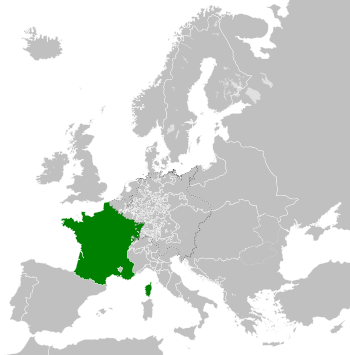Kingdom of France facts for kids
Quick facts for kids
Kingdom of France
Royaume de France (French)
|
|||||||||||||
|---|---|---|---|---|---|---|---|---|---|---|---|---|---|
|
|||||||||||||
|
|
|||||||||||||
|
Motto: Montjoie Saint Denis!
|
|||||||||||||
|
Anthem: Marche Henri IV
(1590–1792,1814–1830) "March of Henry IV" La Parisienne (1830–1848) "The Parisian" |
|||||||||||||

The Kingdom of France in 1789.
|
|||||||||||||
| Capital |
|
||||||||||||
| Common languages | |||||||||||||
| Religion | Roman Catholicism | ||||||||||||
| Government |
|
||||||||||||
| King | |||||||||||||
|
• 987–996
|
Hugh Capet | ||||||||||||
|
• 1180–1223
|
Philip II | ||||||||||||
|
• 1364–1380
|
Charles V | ||||||||||||
| Prime Minister | |||||||||||||
|
• 1815
|
Charles-Maurice de Talleyrand | ||||||||||||
|
• 1847–1848
|
François Guizot | ||||||||||||
| Legislature |
|
||||||||||||
| Chamber of Peers | |||||||||||||
| Chamber of Deputies | |||||||||||||
| Historical era | Medieval / Early Modern | ||||||||||||
|
• Begin of Capetian dynasty
|
3 July 987 | ||||||||||||
| 1337–1453 | |||||||||||||
| 1562–1598 | |||||||||||||
| 5 May 1789 | |||||||||||||
| 6 April 1814 | |||||||||||||
| 2 August 1830 | |||||||||||||
| 24 February 1848 | |||||||||||||
| Currency | Livre, Franc, Écu, Louis d'or | ||||||||||||
| ISO 3166 code | FR | ||||||||||||
|
|||||||||||||
The Kingdom of France (royaume de France) was the name for different governments in France during the Middle Ages and modern times. Historians often point to three main starting points for this kingdom. These are the rule of Clovis in 481, the Treaty of Verdun, or the election of Hugh Capet in 987.
The kingdom lasted until 1792. It was then brought back for short periods between 1814 and 1848.
Contents
The Early Kingdom of France
The King of the Franks, Clovis, made an important agreement with the Catholic Church when he was baptized. This agreement continued throughout the Kingdom of France. Kings were crowned in Reims, which meant they were believed to rule by divine right.
The first kings from the Capetian family wanted to crown their oldest sons while they were still alive. This was because their power was mostly limited to the area around Paris (called the Ile de France). It wasn't until Philip Augustus that kings started using "Kingdom of France" in their official papers. They also began to truly rule over the whole kingdom.
How the Kingdom Grew
The kingdom's land was made up of many smaller areas called fiefs. The King of West Francia was the main ruler, or suzerain, over these fiefs. This system began after the Carolingian Empire was divided in 843.
Over time, these fiefs slowly became part of the king's direct control. This meant the king needed to set up a royal government to manage everything.
Royal Power and Administration
Saint Louis thought it was very important for the king to be a fair judge. He created the parliament, which was the highest court of justice. This helped to make sure laws were followed across the kingdom.
Changes During Wars
The long Hundred Years' War (1337–1453) led to big changes. Under King Charles VII, France created a permanent army and regular taxes. This made the kingdom much stronger.
Later, Cardinal Richelieu, who was a minister for Louis XIII, and King Louis XIV made the king's power even greater. They brought local noble governors under their control. They also sent royal officials, called intendants, to manage the provinces.
Challenges to Royal Power
Sometimes, the king's power was challenged. This happened during times of trouble, like civil wars, or when kings were too young to rule.
The Age of Enlightenment
The ideas of the Age of Enlightenment also challenged the king's absolute power. These new ideas focused on:
- Using reason to govern.
- Separating government powers.
- Protecting individual freedoms.
These ideas became very popular.
End of the Monarchy
The French Revolution led to France trying out a constitutional monarchy. This meant the king's power was limited by a constitution. However, these attempts to keep a king with limited power failed. This happened in 1792, 1830, and 1848. Each failure eventually led to the end of kings ruling France.
Images for kids
-
The Reims Cathedral, built on the site where Clovis I was baptised by Remigius, functioned as the site for the coronation of the Kings of France.
See also
 In Spanish: Reino de Francia para niños
In Spanish: Reino de Francia para niños






